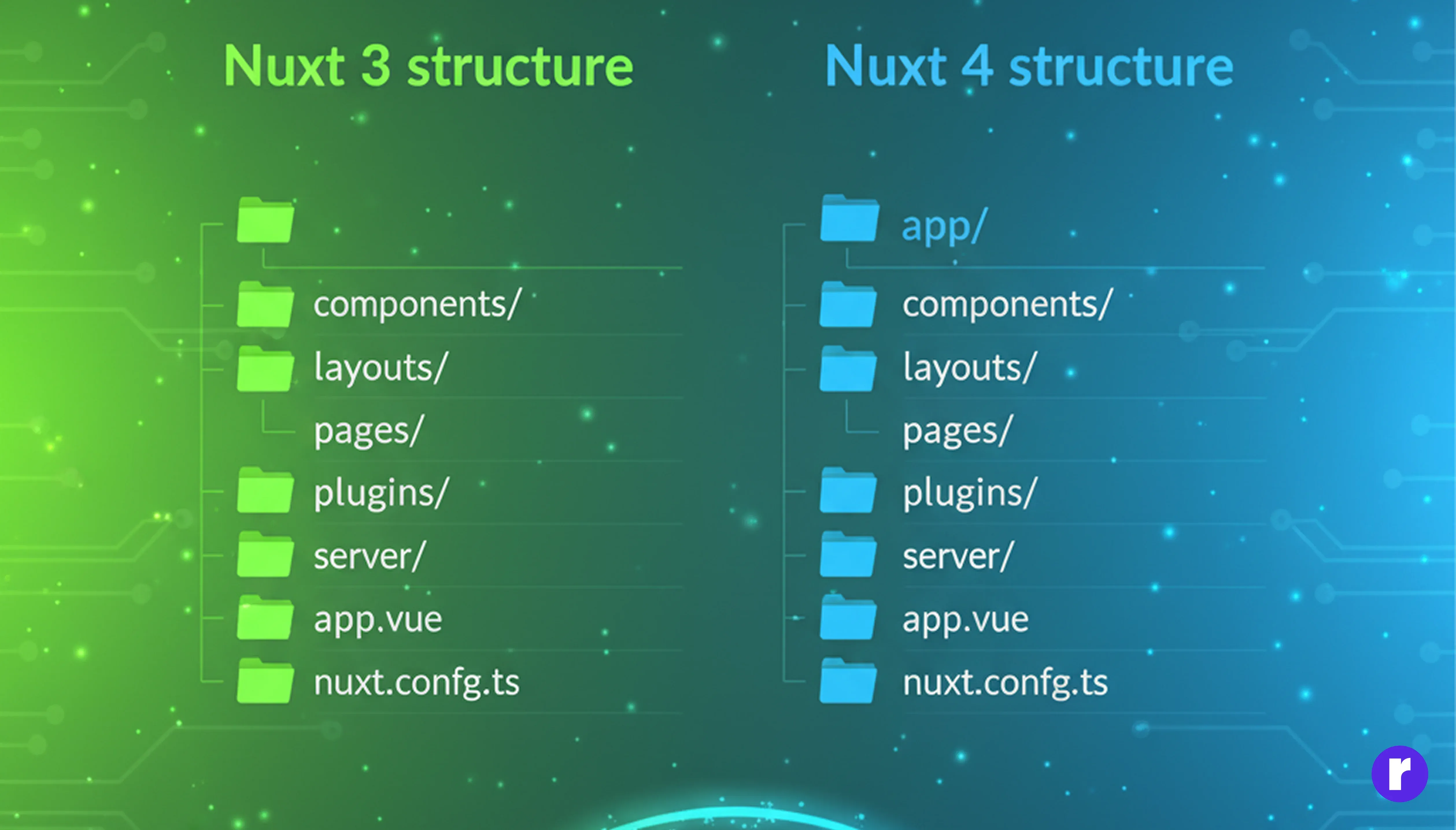Comparing Nuxt 3 and Nuxt 4: Key Features & Upgrades

Written by
Rinkle Poonia
Front End Developer
Keshav Saini
Front End Developer
Table of contents
Build with Radial Code
Nuxt has long been one of the most popular meta-frameworks built on top of Vue. With the release of Nuxt 4, the core team has focused on refinements—improving stability, developer experience, and performance—while preserving the strengths of Nuxt 3. In this post, we’ll compare Nuxt 3 vs Nuxt 4 in terms of features, architecture, breaking changes, and migration considerations. Whether you’re planning a new project or thinking of upgrading, this guide will help you see what’s gained (and lost) in the transition.
Facing Nuxt.js errors? Click here to check out our troubleshooting guide.
What’s New in Nuxt 4
Nuxt 4 is not about flashy new features but about polishing, correcting rough edges, and making the developer experience smoother. Below are the key changes and upgrades.
1. New app/Directory Structure (Optional, but encouraged)

- In Nuxt 4, the conventional directories like components/, pages/, layouts/, plugins/, etc. are now expected to live under an app/folder.
- This reorganization helps with file watcher performance (fewer root-level files to track) and gives clearer separation between application code and server infrastructure.
- Note: Nuxt will still support the “classic” structure for backward compatibility; the migration is optional initiall y.
2. Stricter & Better TypeScript / Type Boundaries

- One of the common frustrations in Nuxt 3 was type bleed: a type from server utilities leaking into client-side code unexpectedly. Nuxt 4 addresses this by creating separate virtual TypeScript projects for app/, server/, and shared/, meaning types are more context-aware.
- The tsconfig.jsonsetup becomes simpler; much of the heavy lifting is handled by Nuxt itself.
- Because of stricter type enforcement, some edge-case issues that went undetected in Nuxt 3 may surface during migration. But that leads to more robust code in the long run.
3. Refined Data Fetching Behavior

- The behavior of useAsyncDataand useFetchis tweaked. In Nuxt 3, stale data was retained while new data loaded in the background (“stale-while-revalidate” style). In Nuxt 4, the old data is cleared immediately on refetch, setting the data ref to null while pending is true. This encourages more deliberate handling of loading states.
- Nuxt4 also changes the default behavior of useAsyncDataand useFetch. The API is the same, but the logic now prioritizes freshness over staleness.
The new default
In Nuxt 3, stale data was retained while new data loaded in the background. This approach prevented loading flashes but resulted in users briefly seeing outdated content.
With Nuxt 4, old data is immediately cleared during a refetch. The datareference is set to nullwhile pendingis true, making it clear that the previous data is no longer valid.
<div v-if="!pending && data">
<h1>{{ data.title }}</h1>
<p>{{ data.body }}</p>
</div>
<div v-else>
Loading...
</div>This encourages developers to design proper loading states instead of relying on stale content.
Restoring the old behavior
If you prefer the “stale-while-revalidate” pattern, you can implement it manually:
const displayData = ref(data.value)
watch(data, (newData) => {
if (newData) {
displayData.value = newData
}
})With this method, users always view existing content until updated data is loaded.
4. Performance, Stability & CLI Improvements

- Faster cold starts - Development server startup is noticeably faster
- Native file watching - Uses fs.watch APIs for fewer system resources
- Node.js compile cache - Automatic reuse of the v8 compile cache
- Socket-based communication - The CLI and Vite dev server now communicate via internal sockets instead of network ports, reducing overhead — particularly on Windows
5. Other Changes & Breaking Adjustments

- Removal of experimental or deprecated features present in Nuxt 3.
- The global window.NUXT object is removed.
- Deduplication of route metadata and some routing index changes.
- Some internal folder scanning behavior in directories has been streamlined
- For module authors: more explicit client/server splits and conditional exports (browser vs node) in package.json become more necessary.
Continue your learning journey at Radial Code .
When Should You Upgrade to Nuxt 4?

In publishing and graphic design, Lorem ipsum is a placeholder text commonly used to demonstrate the visual form of a document or a typeface without relying on meaningful content. Lorem ipsum may be used as a placeholder before the final copy is available.
- Upgrade now if: You’re starting a new project and want the most modern, future-proof stack. Nuxt 4 offers a cleaner architecture, improved type safety, and better performance out of the box.
- Consider upgrading soon if: You need enhanced type safety, faster development workflows, or want to benefit from the latest performance improvements. If you have a solid test suite and can allocate time for migration, the transition will be smoother.
- Wait to upgrade if: Your current Nuxt 3 app is stable, your dependencies are tightly coupled, or you don’t have the bandwidth for a careful migration right now. Nuxt 3 will continue to receive bug fixes for a while, so there’s no immediate rush.
Get more details in our upgrade guide — learn more.
Conclusion
Nuxt 4 doesn’t reinvent the wheel; instead, it refines and strengthens what Nuxt 3 made possible. From a clearer directory structure and stricter type boundaries to more intelligent data fetching and CLI improvements, many of the changes address real pain points in earlier versions.
If you value developer experience, maintainability, and long-term robustness, upgrading to Nuxt 4 is a compelling move—provided you plan carefully, test thoroughly, and tackle migration increments.
